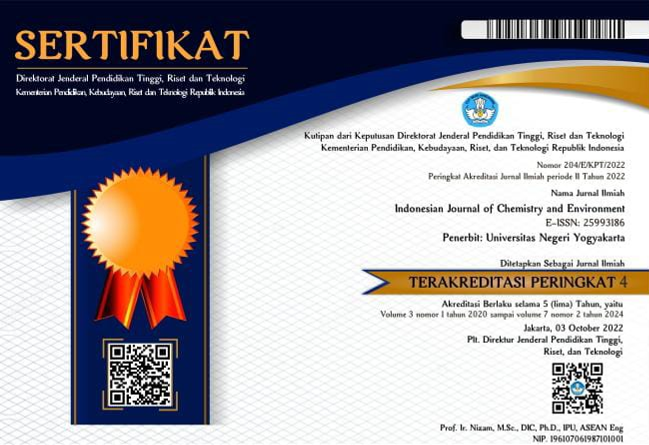The Application of Carbon-Chitosan Composite Imprinted Cu in the Wastewater Treatment
DOI:
https://doi.org/10.21831/ijoce.v4i1.48357Abstract
This research aimed at determining the effect of chitosan in synthesizing imprinted Cu carbon-chitosan composite properties, the effect of imprinting Cu in carbon-chitosan composites to the adsorption efficiency and adsorption capacity of Cu in electroplating waste via batch methods, and the regeneration pattern of the composite. Composites were characterized using FTIR and SEM-EDX. In FTIR spectra, the addition of Cu caused the reduction of -OH and -NH functional groups intensity as the active site of Cu chemical bonding in 3448.72 cm-1. SEM-EDX analysis showed that the carbon-ionic imprinted chitosan composites after desorption contains the element of C = 60.17%, O = 38.8%, Cu = 0.83% and Na = 0.85%. The optimizations of Cu adsorption were studied from the concentration pattern of its variable, measured with Atomic Absorption Spectroscopy (AAS). The results showed that an optimum concentration for adsorption of Cu was 75 mg / L and an optimum contact time for adsorption of Cu was 24 hours with adsorption efficiency of 98.54% and adsorption capacity of 2.62 mg/g respectively. The adsorption yield of electroplating waste showed the adsorption efficiency of 31.62% and adsorption capacity of 367,79 mg/g respectively. Regeneration test was investigated from adsorption-recovery-reactivation (A-Rcov-RAct) steps. This regeneration test was carried out in three cycles. Recovery test was carried out using EDTA 0.05 M and 0.1 M HCl solutions. The efficiency of reactivation was identified from adsorption ability after activated with 0.1 M NaOH from two routes of recoveries. The results showed that recover agents do not influence the adsorption percentage, while to the recovery percentage progress, HCl 0.1M > EDTA 0.05M. All routes of reactivation showed the similar results in average 99%
Downloads
Published
How to Cite
Issue
Section
Citation Check
License
Authors who publish with this journal agree to the following terms:
- Authors retain copyright under a Creative Commons Attribution–ShareAlike License (CC BY SA) that allows others to share: copy, and redistribute the material in any medium or format, Adapt: remix, transform, and build upon the material, for any purpose, even commercially.
- Authors are able to enter into separate, additional contractual arrangements for the non-exclusive distribution of the journal's published version of the work (e.g., post it to an institutional repository or publish it in a book), with an acknowledgement of its initial publication in this journal.
- Authors are permitted and encouraged to post their work online (e.g., in institutional repositories or on their website) prior to and during the submission process, as it can lead to productive exchanges, as well as earlier and greater citation of published work.










